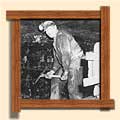 Heritage Community Foundation Presents
Heritage Community Foundation PresentsAlberta Online Encyclopedia
 |
|||
  |
|||
|
Home>> The Industry>> Coal Mining>> Methods>> Room and Pillar |
|||
| Room and Pillar | |||
Through this method, miners created a honeycomb of rooms and pillars that were occasionally bisected by long haulage tunnels. The extent of these tunnels depended on the furthest reaches of seam, and were often several kilometres long. Once miners removed coal from the farthest extent they could reach, they would then backtrack. Since pillar coal was easily accessible, miners would then rob the coal from the pillars. Workers took extensive care when removing this coal since pillar subtraction weakened the roof structure and room would eventually cave in. To prevent cave-in accidents, tunnels also required timbers as pit props, which supported the rocks and prevented smaller debris from falling onto the miners. |
|||
 |
|||
For more on coal mining in Western Canada, visit Peel’s Prairie Provinces.

